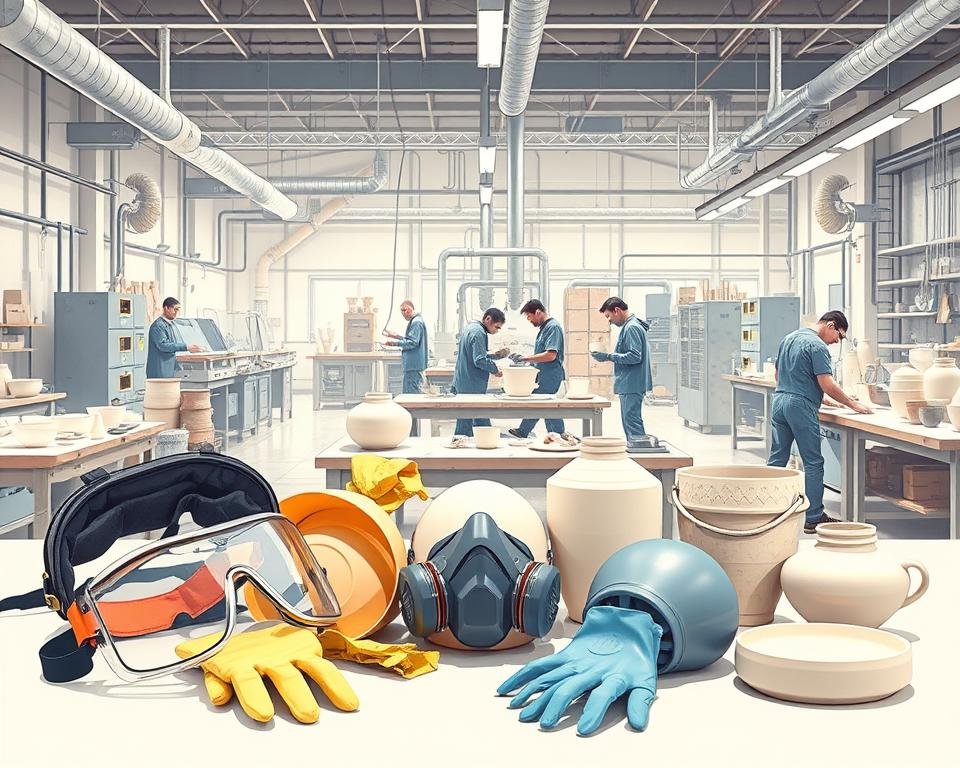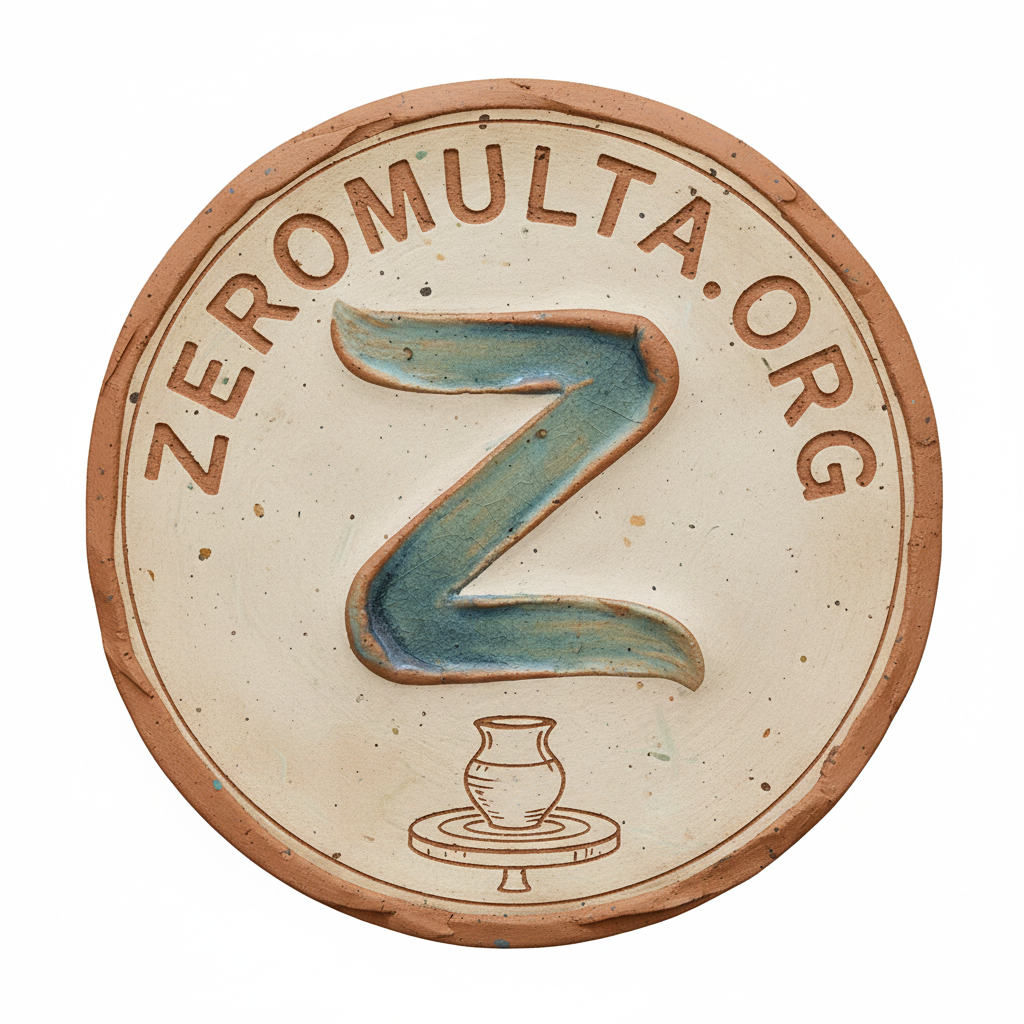As a ceramic professional, you know that exposure to silica dust can be very harmful. The Occupational Safety and Health Administration (OSHA) says over 2 million workers in the U.S. face silica dust each year. Many in the ceramic field are at risk.
I’ve seen how silica dust safety measures can change a workplace. Simple steps can greatly lower the risk of exposure. This makes the work environment healthier for everyone.
Key Takeaways
- Understand the risks associated with silica dust exposure
- Implement personal protective equipment (PPE) to minimize exposure
- Use engineering controls to reduce silica dust in the workplace
- Train employees on the hazards of silica dust and safety protocols
- Regularly monitor the workplace for silica dust exposure
Understanding Silica Dust: What You Need to Know
If you work with ceramics, knowing about silica dust is key. Silica dust is found in many ceramic materials. It poses serious health risks.
What is Silica Dust?
Silica dust is a fine powder that comes from materials like clay and glazes. It’s released when these materials are cut, drilled, or ground.
Common Sources of Silica in Ceramics
Silica is in many ceramic materials. This includes:
- Clay bodies
- Glazes
- Engobes
- Other ceramic materials
These materials can release silica dust when handled or processed.
Health Risks Associated with Silica Exposure
Long-term exposure to silica dust can cause serious health problems. These include:
| Health Risk | Description |
|---|---|
| Silicosis | A lung disease caused by inhaling silica dust |
| Lung Cancer | A type of cancer that can be caused by prolonged silica exposure |
| Kidney Disease | A condition that can be linked to silica exposure |
Understanding these risks is vital. We must take steps to reduce silica dust in ceramics.
Why Silica Dust Safety Matters in the Ceramic Industry
In the ceramic industry, keeping workers safe from silica dust is a top priority. Silica dust, a common byproduct, can cause serious health problems. These include silicosis and other lung diseases.
Protecting Workers’ Health and Safety
Worker health and safety are the most important things in the ceramic industry. Exposure to silica dust can cause serious illnesses. These include silicosis, lung cancer, and kidney disease. It’s vital to have good silica dust control measures in place.
- Regularly monitor the workplace for silica dust.
- Use engineering controls, such as ventilation systems, to reduce dust levels.
- Provide workers with appropriate personal protective equipment (PPE).
By focusing on worker health and safety, ceramic businesses can make their workplaces safer and more productive. OSHA says, “Employers must protect workers from silica exposure. They must use controls and provide PPE.”
“The most effective way to reduce silica exposure is to implement controls that minimize or eliminate the generation of airborne silica dust.”
Legal Regulations and Compliance
Following OSHA regulations for silica in ceramics is not just required; it’s also good for businesses. OSHA has strict rules to limit silica exposure. These include exposure limits and requirements for assessments.
- Understand the OSHA silica standard and its requirements.
- Conduct regular exposure assessments to ensure compliance.
- Implement necessary controls to reduce silica exposure.
By following these rules, ceramic industry employers can avoid fines and penalties. They also ensure a safer workplace. Remember, being proactive in compliance is essential for a successful safety program.
Personal Protective Equipment (PPE) for Safety
To reduce risks from silica dust, the right personal protective equipment is key. As a ceramic worker, I know PPE is vital for safety.
Essential PPE for Ceramic Workers
Protecting against silica dust is important. The right PPE can make a big difference. Here are the must-haves for ceramic workers:
- Respirators: These filter out silica dust, keeping your air clean.
- Gloves: Keep your hands safe from silica dust and other dangers. Choose gloves that are tough and grip well.
- Protective Clothing: Wear coveralls or aprons to stop silica dust from touching your skin and clothes.
- Eye Protection: Safety glasses or goggles shield your eyes from dust and debris.
Proper Usage of Respirators
Respirators are a key part of PPE for silica protection. To use them right:
- Choose the Right Type: Pick a respirator made for silica dust.
- Fit Testing: Make sure it fits well to avoid leaks.
- Regular Replacement: Change filters as the maker says.
Regular Inspection and Maintenance
Keeping PPE in good shape is important. This means:
- Looking for damage or wear
- Cleaning and storing PPE right
- Swapping out PPE when it’s time
By following these tips, ceramic workers can cut down silica dust exposure. This makes the workplace safer.
Best Practices for Minimizing Silica Dust Exposure
Keeping ceramic workers safe from silica dust is key. It starts with good practices. By following these steps, workshops can lower the risks of silica dust.
Wet vs. Dry Methods in Handling Ceramics
Using wet methods is a top way to cut down on silica dust. This means using water or liquids to stop dust when cutting, grinding, or drilling. It’s effective because it keeps silica dust from flying around, lowering the chance of breathing it in.
For example, using a water-fed system when cutting or grinding ceramics can really cut down on dust. The Washington State Department of Health says wet methods are a good way to control silica dust in many industries, including ceramics.

- Reduces airborne silica dust
- Effective for cutting, grinding, and drilling operations
- Can be used with various types of ceramic materials
Effective Housekeeping Protocols
Good housekeeping is also key to reducing silica dust. This means keeping the workshop clean, focusing on areas where dust tends to gather. It’s important to use vacuum cleaners with HEPA filters, as they catch very small particles, like silica dust.
Here are some housekeeping tips:
| Housekeeping Practice | Description | Benefits |
|---|---|---|
| Regular Vacuuming | Use HEPA-filter vacuum cleaners to capture fine silica dust particles. | Reduces dust accumulation, minimizes airborne dust. |
| Dampening Surfaces | Dampen surfaces before sweeping to prevent dust from becoming airborne. | Prevents dust from becoming airborne, reducing inhalation risks. |
| Cleaning Workstations | Regularly clean workstations, tools, and equipment. | Maintains a clean working environment, reduces exposure to silica dust. |
By following these best practices, ceramic workshops can make their work environment safer and healthier. It’s about making safety a priority and following effective protocols to reduce silica dust exposure.
Implementing Engineering Controls
Engineering controls are key in reducing silica dust risks in ceramics. They help ceramic workers stay safe from silica dust.
Local Exhaust Ventilation
Local exhaust ventilation (LEV) systems are very effective. They catch dust at the source, keeping it from spreading. For more info, check out the CDC’s NIOSH page on engineering controls.
Dust-Reducing Machinery
Choosing the right machinery is also important. Look for machines that cut down on dust. This helps keep the workplace cleaner.
Regular maintenance of LEV systems and machinery is vital. It keeps them working well.
Using LEV systems and dust-reducing machinery together greatly reduces silica dust. This makes the workplace safer and healthier for everyone.
Training Employees on Silica Dust Risks
I believe that teaching employees about silica dust risks is key to a safe workplace. As a ceramic expert, it’s more than just following rules. It’s about making sure your team knows how to stay safe.
Importance of Safety Training
Good safety training is crucial for reducing silica dust risks. By investing in solid training, you can help your team spot dangers and act to avoid them.
Some important parts of a great safety training program are:
- Learning about the health dangers of silica dust
- Knowing how to use personal protective equipment (PPE)
- Learning safe ways to handle and process ceramics
Educational Resources and Programs
There are many educational tools and programs to help you create a strong safety training for your team. These include:
| Resource | Description | Benefits |
|---|---|---|
| OSHA Guidelines | Comprehensive guidelines for silica dust safety | Ensures you follow the rules |
| Industry Workshops | Hands-on training sessions for ceramic professionals | Improves practical skills |
| Online Courses | Flexible, self-paced learning opportunities | Easy and convenient |
By using these resources, you can make a training program that fits your team’s needs.

In conclusion, teaching employees about silica dust risks is essential for a safe and healthy ceramic work environment. By focusing on safety training and using available resources, you can keep your employees safe and foster a culture of safety.
Monitoring and Measuring Silica Dust Levels
The first step in minimizing silica exposure is to measure silica dust levels in your workplace. You need to know where and how silica dust is made and spread.
To monitor silica dust well, you must do regular exposure assessments. This means finding out where silica dust is most common and how much there is. Then, you can use specific silica dust control measures to lower exposure.
Understanding Exposure Assessment
Exposure assessment is a detailed process to find out how much silica dust workers breathe in. It involves taking air samples to measure silica dust levels. This information is key to knowing health risks and following safety rules.
A trained professional should do the assessment. They can understand the results and suggest the best ways to control silica dust. Regular checks keep the workplace safe and help make smart choices about silica dust control measures.
Tools for Silica Dust Monitoring
There are many tools for checking silica dust levels, like direct-reading instruments and sampling devices. Direct-reading instruments show silica dust levels as they happen. Sampling devices collect air for later lab tests.
| Tool Type | Description | Benefits |
|---|---|---|
| Direct-Reading Instruments | Provide real-time data on silica dust concentrations | Immediate feedback, allowing for quick adjustments |
| Sampling Devices | Collect air samples for laboratory analysis | Accurate measurement of silica dust levels over a period |
Choosing the right tool depends on your workplace’s needs and tasks. Using these tools regularly helps keep silica dust control measures effective.
By using these tools, you can make your workplace safer for ceramic workers. Regular checks and assessments are vital for a strong safety program to minimize silica exposure.
Building a Culture of Safety in the Workplace
A culture of safety is key in the ceramic industry to lower health risks from silica dust. By making safety a main focus, ceramic workers can greatly cut down on work-related dangers.
Encouraging Safety Communication
Good safety communication is the core of a safe workplace. It means setting up ways for workers to report dangers, share worries, and offer ideas for better safety. Holding safety meetings and having an open-door policy helps workers feel free to talk about risks.
- Hold regular safety training sessions to keep employees informed about the latest safety protocols.
- Use clear signage to communicate hazards and safety procedures throughout the workshop.
- Foster an environment where employees feel comfortable reporting incidents or near-misses without fear of reprisal.
Recognizing Safe Practices
It’s important to praise safe practices to build a safety culture. By thanking employees for following safety rules or suggesting better ways, you encourage others to do the same.
Here are some ways to show appreciation for safe practices:
- Award employees who always follow safety rules.
- Highlight safety heroes in company newsletters or on bulletin boards.
- Give rewards for employees who help make safety better.
By focusing on safety, ceramic workshops can protect their workers from health risks of silica in ceramics. They also create a better and more productive work place.
Responding to Silica Dust Incidents
If a silica dust incident happens, having a plan is very important. It helps keep workers safe and follows the rules. As someone in ceramics, being ready is key to lessening the damage.
Immediate Steps to Take
When silica dust is involved, act fast to cut down on exposure. Make sure everyone in the area uses the right respiratory protection. This could be N95 masks or better, as suggested for ceramic workers.
Move people out of the area if it’s needed. Start cleaning up with wet methods to keep dust down.
Reporting Procedures and Documentation
After acting quickly, follow the right reporting steps. Write down the incident details, like what caused it, where it happened, and how you fixed it. You must follow OSHA regulations for silica in ceramics when reporting.
Keep a detailed record of the incident. This includes any medical help given to workers. This record is key for future checks and showing you followed the rules.
Keeping Updated on Silica Regulations and Guidelines
It’s important to stay informed about silica regulations and guidelines in the ceramic industry. This helps keep the workplace safe. Reliable resources are key for updates on silica dust safety.
Staying Informed
Ceramic professionals can use the Occupational Safety and Health Administration (OSHA) website for guidance. Industry associations and conferences also offer chances to learn about new safety practices.
Adapting to Change
Learning and adapting are essential for effective silica dust safety. By staying committed to education, ceramic workers can reduce risks and keep their workplace safe.
